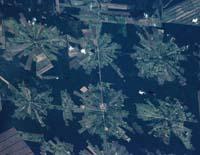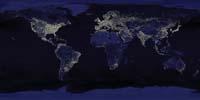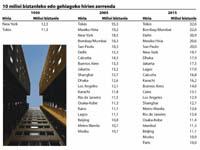Cities, owners of the land

Human influence is evident and also seen from space. This year the UN has published a book with the most striking examples. The book, which features satellite photographs of decades ago and today, explains that the changes have been bigger and faster than ever.
Some of the changes are produced by nature itself: tsunamis, volcanoes, earthquakes... have a lot of strength and are able to transform large areas. In other cases it is not clear what is the cause and scope of human action. For example, many glaciers have receded and, although some believe it is a natural process, others consider it a consequence of human activity.

However, it cannot be denied that many changes have been brought about by man. The South American jungle has been squeezed by man to be agricultural land and has converted humans into 20,000 hectares of land in Almeria, southern Spain. The images of these places are truly representative.
There are many other examples, since in addition to agrarian activity, urbanism also produces changes. For example, the evolution of Miami seems very worrying to the UN. In fact, the expansion of the city to the west is endangering the Everglades ecosystem. The unesco-backed Everglades is one of the largest wetlands in the world and has a very rich ecosystem. If the city reaches there, the damage would be terrible.
Unstoppable urban growth

If we look back, the data is even more significant. In fact, in 1800 only 2% of the population lived in the cities. In 1950 the population was 30% and in 2000 47%. According to the UN, every day there are 180,000 more people in the cities because they were born or have gone to live there. It is estimated that by 2030 60% of the population will live in cities.
In addition, it is in poor countries that cities will grow the most. There, 1.9 billion people met in cities in 2000 and expect to reach 3.9 billion by 2030. In developed countries, however, growth will be slower: It goes from 900 to a billion.

Currently, three-quarters of the population of developed countries is urbanized. By 2030 this proportion will be 84%. In Central and South America, three-quarters of the population are citizens, but in 1960 only half of the population lived in the cities. And yet the population increase in Africa is faster than there.
The population of Africa is mostly rural, and only about a third of the population was occupied by cities in 2000. However, the growth rate is higher than anywhere else, specifically 4.97%, so the growth of the population and cities on this continent is spectacular. Then, after Africa, Asia arrives. It is on these two continents that the largest population growth is concentrated and cities are growing.
Similar at home

There is, however, a certain territorial difference. For example, if in recent decades Zuberoa and Nafarroa Beherea are losing inhabitants, in Lapurdi the population is growing. Precisely on the coast people concentrate mostly. On the other hand, although recently Zuberoa and Baja Navarra have begun to receive people, in many cases it is a second home, as reported by social experts. They consider this to increase the imbalance.
The population is also concentrated in Navarre and Alava. Pamplona and Tudela are the nuclei that are growing in Navarre, while in Álava, Vitoria-Gasteiz concentrates the majority of the population and grows faster than any other place. The villages near these nuclei also grow, but many are becoming dream cities.

Right now there is a big debate about the houses they want to celebrate in Guendulain of Navarra. Ten kilometers from Pamplona is Gendulain, an association that groups most construction companies in the region, with the intention of building 15,000 homes for fifteen years. If so, it would become the second city in Navarre.
In Gipuzkoa and Bizkaia the situation is very different. In both territories it is difficult for this to happen, as they are urbanized differently. The population density of both is higher than the average of the European Union (80 inhab/km 2 in the European Union, 506 in Bizkaia per km 2 and 340 in Gipuzkoa). The largest cities in the Basque Country are also in these two territories, while in the rest there are no cities of more than 100,000 inhabitants, in Gipuzkoa there is one and in Bizkaia three.
Differences between the territories of Euskal Herria. They are due to the industrial development that occurred in the sixteenth century. In addition, the orography has also totally conditioned the urbanization and there are differences between the valley and the valley. In any case, from a general point of view, the Basque Country maintains the same trend as any other developed country, with all its advantages and disadvantages.







